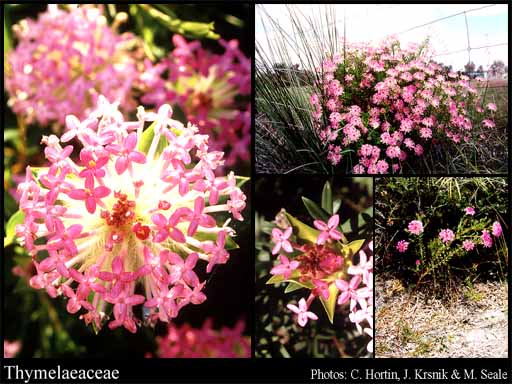- Reference
- Fam.Pl. 2:278 (1763)
- Name Status
- Current

Scientific Description
Common name. Daphne Family.
Habit and leaf form. Shrubs (most), or shrubs, or lianas (rarely), or herbs (rarely). Self supporting (usually), or climbing. Mesophytic, or xerophytic. Leaves small to medium-sized; alternate, or opposite, or whorled; commonly spiral; ‘herbaceous’, or leathery (sometimes ericoid); petiolate to sessile; gland-dotted, or not gland-dotted; simple. Leaf blades entire; flat, or rolled; pinnately veined; cross-venulate. Leaves without stipules; without a persistent basal meristem. Stem anatomy. Nodes unilacunar. Secondary thickening developing from a conventional cambial ring, or anomalous; when anomalous, via concentric cambia (Wikstroemia), or from a single cambial ring.
Reproductive type, pollination. Fertile flowers hermaphrodite, or functionally male and functionally female, or functionally male, or functionally female. Unisexual flowers present, or absent. Plants hermaphrodite, or monoecious, or dioecious, or gynodioecious (with much variation in Pimelea).
Inflorescence and flower features. Flowers solitary, or aggregated in ‘inflorescences’; in racemes, or in heads, or in fascicles. The terminal inflorescence unit racemose. Inflorescences racemes or heads, very condensed; with involucral bracts (often), or without involucral bracts; pseudanthial, or not pseudanthial. Flowers bracteolate, or ebracteolate; regular to somewhat irregular; 4–5 merous. Floral receptacle markedly hollowed (often forming a deep tube of leafy consistency). Free hypanthium nearly always conspicuously present (but ‘more or less absent’ in Synandrodaphne). Hypogynous disk present, or absent; when present, of separate members, or annular. Perianth with distinct calyx and corolla, or sepaline (the corolla sometimes missing or interpretable as staminodes, then the ‘calyx’ commonly more or less petaloid); 4–5, or 8–10, or 11–17; 2 -whorled, or 1 -whorled; isomerous, or anisomerous. Calyx 4–5; 1 -whorled; gamosepalous (usually, variously laciniate or represented by lobes on the hypanthium), or polysepalous (rarely); imbricate; unequal but not bilabiate, or regular; (tube) persistent. Corolla when present, (3–)4–5(–12) (scale-like); 1 -whorled; polypetalous (inserted an the hypanthial tube or at its mouth); imbricate. Fertile stamens present, or absent (from female flowers). Androecium 2 (rarely — Pimelea), or 4–5, or 8, or 10, or 11–100 (usually the same number as the calyx lobes, sometimes double them or ‘many’). Androecial members branched, or unbranched; free of the perianth (at the mouth of the hypanthium), or adnate (to ‘calyx tube’); free of one another; 1 -whorled (when 4–5), or 2 -whorled (when 8 or 10). Androecium exclusively of fertile stamens, or including staminodes (depending on interpretation). Staminodes if so interpreted, 3–12; petaloid (the scalelike ‘petals’ being interpretable as staminodes). Stamens 2, or 4, or 5, or 8, or 10, or 11–35; reduced in number relative to the adjacent perianth (rarely), or isomerous with the perianth, or diplostemonous, or polystemonous; when one whorled, oppositisepalous; filantherous, or with sessile anthers. Anthers dehiscing via longitudinal slits; introrse; tetrasporangiate. Fertile gynoecium present, or absent (from male flowers). Gynoecium 2–5(–12) carpelled. The pistil 1–5 celled. Carpels isomerous with the perianth, or reduced in number relative to the perianth, or increased in number relative to the perianth. Gynoecium syncarpous (but occasionally pseudomonomerous when G2); eu-syncarpous; superior. Ovary unilocular, or plurilocular; 1 locular (occasionally, when G2), or 2–5 locular, or 2 locular. Gynoecium non-stylate, or stylate. Styles 1 (the simple style sometimes with small ‘parastyles’ at the base); apical, or lateral. Stigmas dry type; papillate; Group II type. Placentation when unilocular parietal, or apical; when plurilocular (i.e.usually) axile, or apical. Ovules in the single cavity when unilocular, 1; 1 per locule; pendulous; epitropous; with ventral raphe; arillate (or carunculate); anatropous, or hemianatropous.
Fruit and seed features. Fruit fleshy, or non-fleshy; indehiscent; achene-like, or a berry, or a drupe. Seeds endospermic, or non-endospermic. Cotyledons 2 (flat, expanded). Embryo achlorophyllous (2/3); straight. Seedling. Germination phanerocotylar, or cryptocotylar.
Physiology, biochemistry. Aluminium accumulation not found. Photosynthetic pathway: C3.
Geography, cytology, number of species. World distribution: very widespread, tropical to temperate - more diverse in the Southern hemisphere. X often = 9. 500 species.
Economic uses, etc. Cultivated ornamental shrubs from Daphne, Dais, Dirca (leatherwood), Pimelea (rice flower), etc.
Keys
Western Australian Genera and Families of Flowering Plants — an interactive key
T.D. Macfarlane, L. Watson, N.G. Marchant